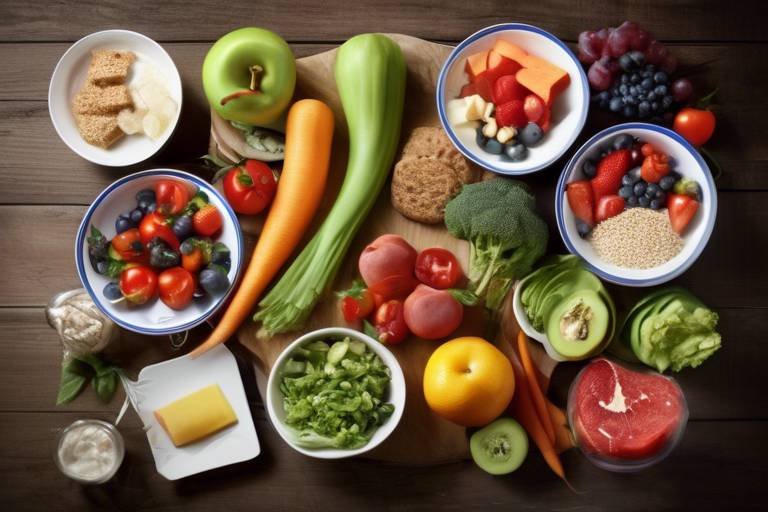Encouraging Healthy Eating Habits among Adolescents
In today's fast-paced world, encouraging healthy eating habits among adolescents has become more crucial than ever. Adolescence is a time of significant change, both physically and emotionally. With the right nutrition, teenagers can not only support their growth and development but also enhance their mental well-being and academic performance. So, how can we instill these habits in our teens? The answer lies in understanding their needs, the role of parents and schools, and implementing practical strategies that resonate with them.
Understanding the nutritional needs of adolescents is essential during this transformative phase. Adolescents experience rapid growth, requiring increased intake of essential nutrients. Proper nutrition supports not only physical health but also mental clarity and emotional stability. Imagine the brain as a high-performance engine; it needs the right fuel to function optimally. Without adequate nutrition, that engine may sputter, leading to poor concentration and decreased academic performance. Thus, it’s vital to emphasize the importance of a balanced diet rich in vitamins, minerals, and macronutrients.
Parents are the primary role models in their children's lives, and this influence extends to eating habits. By modeling good behavior and providing nutritious meals, parents can significantly shape their children's attitudes towards food. For instance, if a parent regularly enjoys fruits and vegetables, their children are likely to follow suit. It’s not just about what’s on the dinner plate; it’s about creating a culture of health within the home.
A supportive home environment is key to encouraging healthy eating. This means stocking the kitchen with nutritious foods and making healthy options readily available. Consider this: if the pantry is filled with chips and sugary snacks, what are the chances that a teenager will choose an apple over a cookie? By involving adolescents in meal planning and grocery shopping, parents can empower them to make better choices. This not only fosters a sense of responsibility but also makes them more aware of their food options.
One of the most effective ways to promote healthy eating is by teaching adolescents basic cooking skills. When teenagers learn how to prepare their own meals, they gain confidence and independence in the kitchen. This knowledge not only leads to healthier eating habits but also encourages creativity. Imagine a teenager experimenting with different ingredients to create a delicious stir-fry—this is how healthy eating becomes a fun and engaging experience!
Regular family meals are an excellent opportunity for bonding and communication. Sharing meals together can reinforce healthy eating habits and create a positive atmosphere around food. It’s a time to discuss the day, share stories, and enjoy each other’s company. Plus, research shows that adolescents who regularly eat with their families tend to consume more fruits, vegetables, and whole grains. So, why not make mealtime a priority?
Schools play a pivotal role in shaping eating habits through nutrition education and providing healthy meal options. Implementing programs that focus on healthy eating can significantly impact students' food choices. Schools can offer workshops on meal planning and cooking, integrate nutrition into the curriculum, and ensure that cafeteria menus feature nutritious options. When schools and families work together, the impact on a child's eating habits can be profound.
There are simple yet effective strategies that can help adolescents make healthier food choices. Encouraging mindful eating, planning meals, and incorporating a variety of foods can lead to better nutrition and overall well-being. For instance, teaching teens to listen to their bodies and recognize hunger cues can promote a healthier relationship with food. Additionally, involving them in meal prep can make them more invested in what they eat.
Encouraging the consumption of fruits and vegetables is essential for a balanced diet. Creative ways to include these foods can make them more appealing to adolescents. For example, smoothies, veggie sticks with hummus, or fruit salads can be delicious alternatives that they may enjoy. The key is to present these options in a fun and engaging way.
Teaching adolescents how to read and understand food labels empowers them to make informed choices. Knowledge of nutritional information can help them select healthier options when shopping or dining out. It’s like giving them a map to navigate the grocery store—once they know what to look for, they can make choices that align with their health goals.
- Why is nutrition important for adolescents? Nutrition is crucial for supporting growth, development, and overall well-being during the teenage years.
- How can parents influence their children's eating habits? By modeling healthy eating behaviors and providing nutritious meals, parents can significantly shape their children's food preferences.
- What role do schools play in promoting healthy eating? Schools can offer nutrition education and provide healthy meal options, creating an environment that supports healthy eating.
- How can adolescents learn to cook? Parents can teach basic cooking skills, encourage experimentation in the kitchen, and involve them in meal preparation.

The Importance of Nutrition for Adolescents
Understanding the nutritional needs of adolescents is crucial, especially during this transformative phase of life. Adolescence is not just a time for emotional and social development; it is also a period of rapid physical growth and cognitive changes. Proper nutrition is like fuel for a high-performance engine, and without it, the engine simply cannot run at its best. During these years, adolescents require a balanced intake of nutrients to support their growing bodies and minds.
Nutrition plays a significant role in various aspects of an adolescent's life, including physical health, mental well-being, and even academic performance. For instance, a diet rich in fruits, vegetables, whole grains, and lean proteins can enhance concentration and memory, which are essential for learning. Conversely, diets high in processed foods and sugars can lead to fatigue, irritability, and even depression. It's like trying to drive a car with low-quality fuel; it simply won't perform to its potential.
Moreover, adolescents are often influenced by peer pressure and societal trends, making them more susceptible to unhealthy eating habits. This is where the importance of nutrition becomes even more pronounced. A well-rounded diet not only supports physical growth but also boosts self-esteem and body image. When adolescents feel good about their bodies, they are more likely to participate in physical activities, which further promotes a healthy lifestyle.
To illustrate the importance of nutrition, consider the following key nutrients that are vital during adolescence:
- Calcium: Essential for bone development, especially during the growth spurts typical of this age.
- Iron: Important for energy levels and cognitive function; deficiency can lead to fatigue and poor concentration.
- Vitamins A and C: Crucial for immune function and skin health, helping adolescents fend off illnesses and maintain a healthy appearance.
- Protein: Necessary for muscle growth and repair, supporting an active lifestyle.
In summary, the importance of nutrition for adolescents cannot be overstated. It serves as the foundation for a healthy lifestyle and sets the stage for lifelong habits. By focusing on balanced nutrition, we can help adolescents navigate this challenging time with confidence and vigor, ensuring they are equipped to face the world around them.
Q: Why is nutrition particularly important during adolescence?
A: Adolescence is a critical period of growth and development. Proper nutrition supports physical health, mental well-being, and academic performance.
Q: What are some essential nutrients adolescents need?
A: Key nutrients include calcium for bone health, iron for energy, and vitamins A and C for immune function.
Q: How can parents encourage healthy eating habits?
A: Parents can model healthy eating behaviors, provide nutritious meals, and involve adolescents in meal planning and preparation.

Role of Parents in Shaping Eating Habits
Parents are often the unsung heroes when it comes to shaping their children's eating habits. Think about it: from the moment a child is born, parents are the primary influencers in their lives, including what goes into their mouths. It's not just about putting food on the table; it's about creating an environment where healthy eating is not only encouraged but celebrated. By modeling good eating behaviors, parents can instill a love for nutritious foods that can last a lifetime.
Imagine a scenario where a family sits down for dinner, and the table is filled with vibrant fruits, colorful vegetables, and wholesome grains. This visual feast does more than just satisfy hunger; it teaches children that healthy food can be both delicious and fun. So, how can parents make this a reality? Here are some strategies:
- Lead by Example: Children are like sponges; they absorb everything around them. If they see their parents enjoying a variety of healthy foods, they are more likely to want to try them too.
- Involve Them in Meal Prep: Letting adolescents help with meal planning and preparation not only teaches them valuable skills but also gives them a sense of ownership over their food choices.
- Make Healthy Choices Accessible: Stocking the pantry with nutritious snacks and meals makes it easier for teens to make better choices when hunger strikes.
Creating a healthy home environment is essential, but it goes beyond just food choices. It's about fostering a positive attitude towards eating. For instance, parents can encourage family meals, which serve as a platform for discussion and connection. These shared moments can reinforce the idea that healthy eating is a family value, rather than a chore. During these meals, parents can introduce new foods and talk about their benefits, making the experience educational and enjoyable.
Moreover, teaching adolescents basic cooking skills can be a game changer. When teens learn to cook, they gain confidence in their ability to create meals that are both tasty and nutritious. This newfound independence can lead to a greater appreciation for food and a desire to experiment with different ingredients. Imagine your teen whipping up a colorful stir-fry packed with vegetables; not only is it a win for their health, but it also sparks creativity and self-expression.
Lastly, let's not forget the power of communication. Parents should engage in open discussions about food, health, and nutrition. This dialogue can demystify the world of healthy eating and help adolescents navigate their choices with confidence. By addressing questions and concerns, parents can support their children in making informed decisions about their diets.
In summary, the role of parents in shaping eating habits is multifaceted. Through example, involvement, and open communication, parents can create a nurturing environment that encourages healthy eating. After all, the habits formed during adolescence can carry into adulthood, making this an important investment in their future well-being.
Q: How can I encourage my teen to eat healthier without being pushy?
A: Start by introducing a variety of foods at home and making them accessible. Involve your teen in cooking and meal planning, and have open discussions about nutrition. The goal is to create a positive atmosphere around food, rather than making it feel like a chore.
Q: What if my teen is a picky eater?
A: Picky eating is common among adolescents. Try to introduce new foods gradually and pair them with favorites. Encourage them to participate in choosing and preparing meals, which can help them feel more in control and willing to try new things.
Q: How important are family meals in promoting healthy eating?
A: Family meals are crucial for fostering healthy eating habits. They provide an opportunity for bonding, discussion, and the introduction of new foods in a supportive environment. Regular family meals can significantly influence children's attitudes towards food.

Creating a Healthy Home Environment
Creating a healthy home environment is like setting the stage for a fantastic play; it requires the right props, lighting, and atmosphere to ensure that everything flows smoothly. When it comes to encouraging healthy eating habits among adolescents, the home is the primary setting where these habits are formed. Imagine walking into a kitchen filled with colorful fruits and vegetables, whole grains, and lean proteins—this is the kind of environment that not only looks appealing but also promotes better food choices. By stocking the kitchen with nutritious foods, parents can influence their children's eating behaviors in a positive way.
But it doesn't stop at just having the right foods available. Involving adolescents in meal planning is another powerful strategy. When kids have a say in what goes on their plates, they are more likely to be excited about the meals prepared. Think of it as giving them a paintbrush to create their culinary masterpiece. This not only fosters a sense of ownership but also teaches them valuable skills that they will carry into adulthood. For instance, a weekly family meeting to discuss meal ideas can be both fun and educational, allowing everyone to contribute their preferences while learning about nutrition.
Moreover, engaging adolescents in cooking can significantly enhance their confidence and creativity in the kitchen. Imagine a scenario where a teenager whips up a colorful stir-fry packed with vegetables and lean protein after learning how to sauté and season from a parent. This experience not only encourages healthier eating but also instills a sense of independence. Cooking becomes less of a chore and more of an art form, where they can express themselves while nourishing their bodies.
Additionally, creating a healthy home environment means making mealtime a special occasion. Regular family meals are not just about the food; they are a time for connection and communication. Picture a bustling dinner table where laughter and stories are shared over a delicious home-cooked meal. This atmosphere reinforces healthy eating habits and creates a positive relationship with food. It’s a moment where adolescents can learn about portion control, the importance of balance, and even the joy of trying new foods in a supportive setting.
In summary, a healthy home environment is a blend of nutritious food availability, active involvement in meal planning and cooking, and fostering family connections during mealtime. When these elements come together, they create a nurturing space that encourages adolescents to develop lifelong healthy eating habits. After all, the home is where the journey to a healthier lifestyle begins, and it can be a fun and fulfilling adventure!
- How can I encourage my teenager to eat healthier? Start by involving them in meal planning and cooking, making the process fun and educational.
- What are some easy healthy snacks for adolescents? Consider options like yogurt with fruits, veggie sticks with hummus, or whole-grain crackers with cheese.
- How important are family meals? Family meals are crucial as they provide an opportunity for bonding, communication, and reinforcing healthy eating habits.

Encouraging Cooking Skills
Teaching adolescents basic cooking skills is not just about whipping up a meal; it's about instilling a sense of confidence and independence that can last a lifetime. Imagine a teenager who can prepare a nutritious dinner for themselves after a long day at school—how empowering is that? By learning to cook, they develop a critical life skill that not only enhances their overall well-being but also fosters creativity in the kitchen. Cooking can be seen as an art form, where the kitchen is the canvas and the ingredients are the colors. When adolescents engage in this creative process, they are more likely to take pride in their food choices.
Moreover, cooking together can be a fantastic bonding experience for families. Picture this: a parent and their child chopping vegetables, laughing, and sharing stories while preparing a meal. This shared experience can strengthen family ties and create lasting memories. Not only does it make cooking more enjoyable, but it also opens up conversations about nutrition and healthy eating habits. When adolescents participate in meal preparation, they become more aware of what goes into their food, making them more likely to choose healthier options.
To get started, parents can encourage their teens to take part in simple cooking tasks. For instance, they can begin with basic recipes that require minimal ingredients and steps. Here are a few ideas to spark their interest:
- Making smoothies with fruits and yogurt
- Preparing simple salads with a variety of colorful vegetables
- Baking whole-grain muffins or cookies
As their skills grow, so can the complexity of the recipes. Encouraging adolescents to experiment with spices and flavors can turn cooking into an exciting adventure. They might discover a passion for cooking that they never knew they had! Additionally, parents can introduce them to healthy cooking techniques such as steaming, grilling, or baking instead of frying. This not only makes meals healthier but also teaches valuable cooking methods that they can use throughout their lives.
In summary, by encouraging cooking skills among adolescents, we are not just teaching them how to prepare food; we are equipping them with essential tools for a healthier lifestyle. It’s about creating a foundation for making informed food choices, fostering a love for nutritious meals, and building connections with family and friends through the joy of cooking. So, why not get started today? The kitchen is waiting!
Q: What are some easy recipes I can teach my adolescent?
A: Start with simple recipes like smoothies, salads, or whole-grain muffins. These require minimal ingredients and can be made quickly, making them perfect for beginners.
Q: How can cooking together impact family dynamics?
A: Cooking together fosters communication and bonding. It creates a relaxed environment where family members can share stories and experiences while preparing a meal.
Q: What if my adolescent is not interested in cooking?
A: Encourage them by involving them in the process gradually. Start with fun and simple tasks, and let them explore different aspects of cooking at their own pace.

Family Meals: A Time for Connection
Family meals are more than just a time to eat; they are a vital opportunity for connection and communication among family members. In today’s fast-paced world, where everyone seems to be constantly on the go, sitting down together for a meal can feel like a rare treat. However, it’s essential to carve out this time in our busy lives. Sharing meals as a family fosters a sense of belonging and strengthens relationships, creating a warm atmosphere where everyone feels valued and heard.
During family meals, the table becomes a hub of interaction. It’s a time to share stories, discuss the day’s events, and even tackle challenges together. This ritual not only enhances emotional bonds but also provides a platform for adolescents to express themselves openly. When parents and children gather around the table, it encourages open dialogue, allowing them to discuss everything from school projects to personal struggles. This connection can significantly impact an adolescent’s mental well-being and self-esteem.
Moreover, family meals can serve as a teaching moment. Parents can impart valuable lessons about nutrition, portion sizes, and the importance of a balanced diet while preparing meals together. This hands-on approach can be both educational and fun, making healthy eating a family affair. For instance, involving adolescents in meal preparation can spark their interest in cooking and nutrition, leading them to make healthier choices on their own.
To maximize the benefits of family meals, consider the following tips:
- Establish a Routine: Try to have at least one meal together each day, whether it’s breakfast, lunch, or dinner. Consistency helps everyone prioritize this time.
- Create a Comfortable Atmosphere: Make the dining area inviting. Use tablecloths, candles, or even play soft music to enhance the dining experience.
- Limit Distractions: Put away phones and turn off the TV. Focus on each other and the food.
- Encourage Participation: Rotate cooking responsibilities among family members. This not only lightens the load but also allows everyone to contribute and feel involved.
In essence, family meals are a powerful tool for nurturing healthy eating habits and fostering emotional connections. They create a safe space where adolescents can learn about food, develop their cooking skills, and engage in meaningful conversations. By prioritizing family meals, we not only promote better nutrition but also cultivate a supportive family environment that can guide adolescents toward making healthier choices throughout their lives.
1. How often should families aim to eat together?
It's ideal to aim for at least one meal together each day. However, even a few times a week can make a significant difference in family bonding.
2. What if family members have different schedules?
Try to be flexible. You can have breakfast together or even a weekend brunch. The key is to find a time that works for everyone.
3. How can we make meals more engaging for adolescents?
Involve them in the cooking process, let them choose recipes, or even have themed dinner nights to make meals more exciting.
4. What if my adolescent is a picky eater?
Encourage them to try new foods by incorporating them into meals gradually. Make it a fun challenge to explore different flavors together.

School's Role in Promoting Healthy Eating
Schools are more than just places for academic learning; they are vital environments where healthy habits can be cultivated. The role of schools in promoting healthy eating cannot be overstated. With adolescents spending a significant portion of their day in school, it’s the perfect setting to instill good nutritional practices. Imagine a world where every school cafeteria becomes a beacon of health, offering meals that not only nourish but also excite the taste buds. This is not just a dream; it’s a reality that can be achieved through thoughtful initiatives.
One of the primary ways schools can promote healthy eating is through nutrition education. By integrating lessons on the importance of balanced diets, food groups, and the benefits of consuming whole foods, schools can empower students to make informed choices. For instance, when students understand the impact of sugary snacks on their energy levels and mood, they might think twice before reaching for that candy bar. Incorporating hands-on activities, like cooking classes or gardening, can further enhance their understanding and appreciation of healthy foods.
Moreover, schools can provide healthy meal options in their cafeterias. This means not only offering fruits and vegetables but also ensuring that these options are appealing and accessible. A well-planned menu can include colorful salads, whole grain options, and lean proteins that cater to diverse tastes. By showcasing these healthy choices, schools can create an environment where students are more likely to opt for nutritious meals. For example, a table could be set up to highlight the nutritional benefits of certain foods, making it easier for students to choose wisely:
| Food Item | Nutritional Benefits |
|---|---|
| Spinach | Rich in iron and vitamins A, C, and K |
| Quinoa | High in protein and fiber, gluten-free |
| Blueberries | Loaded with antioxidants and vitamins |
Additionally, schools can foster a culture of healthy eating through school-wide programs that involve students, parents, and the community. Initiatives like “Healthy Eating Weeks” or “Farm to School” programs can encourage students to try new foods and learn about where their food comes from. These programs can also include workshops for parents, helping them understand how to support their children’s healthy eating habits at home.
Finally, creating a supportive environment goes beyond just food offerings. Schools can promote healthy eating by providing safe and inviting spaces for students to enjoy their meals. This means ensuring that lunch areas are clean, comfortable, and conducive to socializing. When students feel relaxed and happy during mealtimes, they are more likely to enjoy their food and make healthier choices.
In conclusion, schools play a pivotal role in shaping the eating habits of adolescents. By prioritizing nutrition education, providing healthy meal options, and fostering a supportive environment, schools can significantly influence students' food choices. The journey towards healthier eating starts here, and with the right strategies in place, we can empower the next generation to make choices that benefit their health for a lifetime.
- Why is nutrition important for adolescents? Nutrition is crucial during adolescence as it supports growth, development, and overall well-being.
- How can parents help their children eat healthier? Parents can model healthy eating behaviors, involve children in meal planning, and create a nutritious home environment.
- What role do schools play in promoting healthy eating? Schools can educate students about nutrition, provide healthy meal options, and create supportive eating environments.
- How can adolescents learn to read food labels? Teaching them the basics of food labels, including serving sizes and nutrient information, empowers them to make informed choices.

Practical Tips for Healthy Eating
When it comes to fostering healthy eating habits among adolescents, it's all about making smart choices feel effortless and enjoyable. After all, who wants to feel like they’re on a diet? Instead, let’s think of it as a lifestyle upgrade! One of the best ways to encourage this shift is through mindful eating. This means being present during meals, savoring each bite, and recognizing hunger and fullness cues. By doing so, adolescents can develop a more positive relationship with food, making them less likely to overeat or make impulsive choices.
Meal planning can also be a game-changer. Imagine sitting down at the beginning of the week to map out meals together as a family. This not only saves time during busy weekdays but also ensures that healthy options are always on the table. By involving adolescents in this process, they learn to appreciate the value of planning and can even take ownership of their meals. Plus, it’s an excellent opportunity to introduce new, nutritious ingredients, transforming the kitchen into a creative space rather than a chore.
Now, let’s talk about incorporating fruits and vegetables. It’s essential to make these vibrant foods enticing. Try setting up a colorful fruit bowl on the kitchen counter or creating fun veggie platters with dips. You could even host a “fruit and veggie night” where everyone gets to create their own dishes. By making these foods visually appealing and interactive, adolescents are more likely to reach for them. Remember, the more they see these options, the more they’ll crave them!
Another key aspect is understanding food labels. It might sound boring, but teaching adolescents how to read and interpret labels can empower them like nothing else. When they know what’s in their food, they can make informed choices that align with their health goals. Consider creating a fun game out of it: challenge them to find the healthiest snack at the grocery store based on nutritional information. This not only makes shopping more engaging but also reinforces the importance of making smart food choices.
Lastly, let’s not forget the power of hydration. Drinking enough water is crucial for overall health, yet many adolescents overlook it. Encourage them to carry a reusable water bottle and set reminders to drink throughout the day. You can even jazz it up by adding slices of fruit or herbs to their water for a refreshing twist. Staying hydrated can improve concentration, energy levels, and overall mood, making it a simple yet effective way to boost their health.
In conclusion, promoting healthy eating habits among adolescents doesn’t have to be a daunting task. By incorporating these practical tips into daily life, we can create an environment that supports better nutrition and fosters a lifelong appreciation for healthy foods. Remember, it’s all about making healthy choices fun, engaging, and part of everyday life!
- How can I encourage my teenager to eat more fruits and vegetables?
Start by making fruits and vegetables easily accessible and visually appealing. Get them involved in meal prep and offer a variety of options to keep things interesting.
- What are some quick healthy snacks for busy adolescents?
Some great options include yogurt with fruit, nuts and seeds, whole-grain crackers with cheese, or sliced veggies with hummus.
- How can I help my child understand food labels?
Take them shopping and explain how to read labels together. Highlight important aspects like serving size, calories, and nutritional content to make it relatable.

Incorporating Fruits and Vegetables
When it comes to healthy eating, fruits and vegetables are the true champions! They are packed with essential vitamins, minerals, and fiber, making them a vital part of any adolescent's diet. But how can we make these colorful foods more appealing to teenagers who might prefer fast food or sugary snacks? It’s all about creativity and presentation! Imagine turning a boring plate of greens into a vibrant rainbow salad that looks as good as it tastes. The key is to make these foods not just a part of their meals, but a delightful experience.
One effective strategy is to involve adolescents in the selection and preparation of fruits and vegetables. When teenagers have a hand in choosing what goes on their plates, they are more likely to eat it. Take them to the grocery store or a local farmer's market, and let them pick out their favorite produce. You could even challenge them to find a new fruit or vegetable each week! This not only makes shopping fun but also teaches them about seasonal produce and the benefits of eating fresh.
Another fun idea is to incorporate fruits and vegetables into their favorite dishes. For instance, adding spinach or kale to smoothies can create a nutritious drink that tastes delicious, especially when blended with bananas and berries. Or, how about sneaking some grated zucchini or carrots into pasta sauces? It’s like a stealthy health upgrade! Here’s a quick table to illustrate some easy ways to add more fruits and veggies to meals:
| Meal | Fruits & Vegetables to Add | Tips |
|---|---|---|
| Smoothies | Spinach, Kale, Berries, Bananas | Blend until smooth for a nutrient-packed drink! |
| Pasta | Broccoli, Zucchini, Bell Peppers | Sauté before mixing with sauce for extra flavor. |
| Snacks | Carrot Sticks, Apple Slices, Hummus | Pair with dips to make them more appealing. |
Don't forget about the power of snacks! Keeping cut-up fruits and vegetables ready to grab in the fridge can make healthy choices easier. Think of it as setting up a mini health station at home. When hunger strikes, having colorful, crunchy options available can prevent the temptation of reaching for chips or candy. Plus, it’s a great way to satisfy those afternoon cravings without the guilt!
Lastly, let’s not overlook the importance of education. Teaching adolescents about the health benefits of fruits and vegetables can spark their interest. Discuss how these foods can improve their energy levels, boost their immune systems, and even enhance their skin health. When they understand the “why” behind the importance of these foods, they may be more inclined to incorporate them into their diets.
In conclusion, incorporating more fruits and vegetables into an adolescent's diet doesn’t have to be a chore. With a little creativity, involvement, and education, these nutritious foods can become a staple in their everyday meals. So, let’s get those fruits and veggies on their plates and watch them thrive!
- Why are fruits and vegetables important for adolescents?
Fruits and vegetables provide essential nutrients that support growth, development, and overall health during the adolescent years. - How can I encourage my teenager to eat more fruits and vegetables?
Involve them in shopping and cooking, make healthy snacks readily available, and educate them about the benefits of these foods. - What are some easy ways to incorporate fruits and vegetables into meals?
Try adding them to smoothies, pasta dishes, or as part of snacks with dips. Creativity is key!

Understanding Food Labels
Understanding food labels is like having a secret decoder ring for your health. When adolescents learn to read these labels, they gain the power to make informed choices about what they eat. This knowledge is incredibly important, especially during a time when their bodies are growing and changing rapidly. But what exactly should they look for on a food label? Let’s break it down.
First, it’s essential to understand the Nutrition Facts panel. This panel provides a wealth of information about the food item. It includes details such as serving size, calories, and the amount of various nutrients like fats, carbohydrates, and proteins. For example, if a food item lists a serving size of one cup but the adolescent eats two cups, they need to double the calories and nutrients listed to understand what they are actually consuming.
Next up, the ingredient list is another crucial component. Ingredients are listed in descending order by weight, meaning the first few ingredients make up the majority of the product. If sugar is one of the first ingredients, it’s a red flag! Adolescents should be encouraged to choose products where whole foods, like fruits and vegetables, are at the top of the list. This is a great way to ensure they are consuming more nutritious options.
Moreover, understanding serving sizes is vital. Many people overlook this aspect, thinking that the entire package is one serving. For instance, a bag of chips may have multiple servings, and consuming the entire bag can lead to unintentional overeating. Teaching adolescents to pay attention to serving sizes can help them control their portions and maintain a balanced diet.
To further empower adolescents, here are some key points they should remember when checking food labels:
- Look for Whole Grains: Whole grains should be listed as one of the first ingredients.
- Watch Out for Added Sugars: Be cautious of products with high amounts of added sugars.
- Check Sodium Levels: Aim for lower sodium options to maintain heart health.
- Know Your Fats: Choose products with healthy fats, like those from nuts and avocados, while avoiding trans fats.
Finally, it’s important to remember that not all foods are created equal. Some items might boast “low fat” or “sugar-free,” but that doesn’t always mean they are healthy. Often, manufacturers compensate for the lack of fat or sugar by adding other ingredients that may not be beneficial. Therefore, adolescents should be encouraged to look beyond the claims on the front of the package and dive deeper into the actual nutritional content.
In conclusion, understanding food labels equips adolescents with the knowledge they need to make healthier food choices. It’s about empowering them to take control of their nutrition, ensuring they are not just eating for the sake of eating but are making choices that will support their growth and development. By fostering this skill, we can help them build a foundation for a lifetime of healthy eating habits.
1. Why is it important to understand food labels?
Understanding food labels helps you make informed choices about what you eat, ensuring you consume a balanced diet that supports your growth and health.
2. What should I look for on a food label?
Look for serving sizes, calories, and the ingredient list. Pay attention to the amounts of sugar, sodium, and types of fats included.
3. How can I teach my teen to read food labels?
Start by going through common food items together, discussing each part of the label, and encouraging them to ask questions about what they see.
4. What are some common misconceptions about food labels?
Many people think that terms like "low fat" or "sugar-free" automatically mean a product is healthy. It's important to read the full label to understand what else is included.
Frequently Asked Questions
- Why is nutrition so important for adolescents?
Nutrition is incredibly important for adolescents because this is a time of rapid growth and development. Proper nutrition supports not only their physical health but also their mental well-being and academic performance. Think of it as fueling a high-performance engine; without the right fuel, it won't run efficiently!
- How can parents encourage healthy eating habits?
Parents can encourage healthy eating habits by modeling good behavior, providing nutritious meals, and creating a supportive home environment. Involving adolescents in meal planning and preparation can empower them to make better food choices. It's like teaching them to fish instead of just giving them fish!
- What role do schools play in promoting healthy eating?
Schools play a pivotal role by offering nutrition education and healthy meal options. Implementing programs that focus on healthy eating can significantly impact students' food choices. Imagine schools as the training ground where young minds can learn the importance of nutrition!
- What are some practical tips for adolescents to eat healthily?
Some practical tips include encouraging mindful eating, planning meals ahead of time, and incorporating a variety of foods into their diet. Simple changes can lead to better nutrition and overall well-being, making healthy eating feel less like a chore and more like an exciting adventure!
- How can we make fruits and vegetables more appealing to adolescents?
Making fruits and vegetables more appealing can be as simple as incorporating them into fun recipes or presenting them in creative ways. Think of colorful fruit smoothies or veggie dips that are not only tasty but also visually appealing. It's all about making healthy choices exciting!
- Why should adolescents learn to read food labels?
Learning to read food labels empowers adolescents to make informed choices about what they eat. Understanding nutritional information helps them select healthier options when shopping or dining out. It's like giving them a map to navigate the grocery store jungle!



















